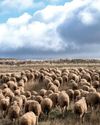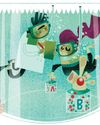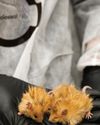Versuchen GOLD - Frei
HOW DOWN SYNDROME MAKES A BRAIN Beautifully DIFFERENT
Muse Science Magazine for Kids
|September 2023
Seeing people for their abilities, not their diagnoses

When Charlotte Woodward was born, she had a genetic condition called Down syndrome. Doctors told her parents that she'd most likely never learn to read or write. All she could expect as an adult, they said, was a job in a sheltered workshop making less than minimum wage.
"My mom knew that wasn't right, so she didn't take those words to heart," Woodward, now 33, says.
"She instilled in me a love of education, and I started learning to read when I was three and a half years old."
Woodward has a degree in sociology from George Mason University in Virginia. Her studies concentrated in inequality and social change. In the past decade, she's written several articles that have appeared in medical journals and has contributed to a chapter of a book. One TikTok she made about discrimination that people with Down syndrome face has received more than three million views.

What Is Down Syndrome?
In the United States, one in every 700 babies is born with Down syndrome. It's a genetic condition caused by an extra copy of an individual's 21st chromosome. Kids with Down syndrome may be short in stature and have low muscle tone, which can affect their speech. They also possess intellectual disabilities to varying degrees. This means that it may be particularly challenging for them to learn new information and skills.
Diese Geschichte stammt aus der September 2023-Ausgabe von Muse Science Magazine for Kids.
Abonnieren Sie Magzter GOLD, um auf Tausende kuratierter Premium-Geschichten und über 9.000 Zeitschriften und Zeitungen zuzugreifen.
Sie sind bereits Abonnent? Anmelden
WEITERE GESCHICHTEN VON Muse Science Magazine for Kids

Muse Science Magazine for Kids
ANIMAL FIREFIGHTER TO THE RESCUE
Can animals help manage the risks of deadly wildfires?
3 mins
Muse July 2025: The Story Behind Wildfires

Muse Science Magazine for Kids
FIRE DANGER
WHY THE RISK OF WILDFIRES KEEPS GROWING
4 mins
Muse July 2025: The Story Behind Wildfires

Muse Science Magazine for Kids
The Miller NEW Normal
WHAT TODAY’S WILDFIRES TELL US ABOUT OUR FUTURE
8 mins
Muse July 2025: The Story Behind Wildfires

Muse Science Magazine for Kids
WOMEN AND FIREFIGHTING: A GOOD FIT
Jessica Gardetto is a firefighter. Her father was, too. “I grew up with my dad coming home smelling like wildfire and covered in soot,” she says.
1 min
Muse July 2025: The Story Behind Wildfires

Muse Science Magazine for Kids
What is happening on your fingertips when they get all wrinkly in a hot tub?
—Felix G., age 10, Montana
1 mins
Muse July 2025: The Story Behind Wildfires

Muse Science Magazine for Kids
WHEN the SMOKE CLEARS
THE LINGERING EFFECTS OF THE RECENT PACIFIC PALISADES AND ALTADENA EATON FIRES
6 mins
Muse July 2025: The Story Behind Wildfires

Muse Science Magazine for Kids
PICKING TEAMS
Keep it fair with a strategy that relies on geometry.
2 mins
Muse July 2025: The Story Behind Wildfires

Muse Science Magazine for Kids
SHAN CAMMACK
WILDLIFE BIOLOGIST AND FIRE SAFETY OFFICER
3 mins
Muse July 2025: The Story Behind Wildfires

Muse Science Magazine for Kids
Scientists Create Mice With Woolly Mammoth-Like Fur
RESEARCHERS AT A COMPANY IN TEXAS ARE WORKING TO CREATE A LIVING ANIMAL THAT RESEMBLES THE EXTINCT WOOLLY MAMMOTH. Recently, they produced mice with traits of the large mammal. The mice all have coats with mammoth-like fur, and some of the small mammals also have genes that help them store fat. Both features would help the animals survive in the cold Arctic, where the woolly mammoth once lived.
1 min
Muse July 2025: The Story Behind Wildfires

Muse Science Magazine for Kids
Cool Sunshade Added to the Nancy Roman Space Telescope
THE NANCY ROMAN SPACE TELESCOPE IS A NEW TELESCOPE THAT NASA IS BUILDING AND WILL LAUNCH INTO SPACE, LIKELY IN EARLY 2027.
1 min
Muse July 2025: The Story Behind Wildfires
Translate
Change font size
